In this guide, we will explore a diverse selection of these evergreen beauties, detailing their characteristics, care requirements, and the unique charm they bring to any garden.
Gardenia
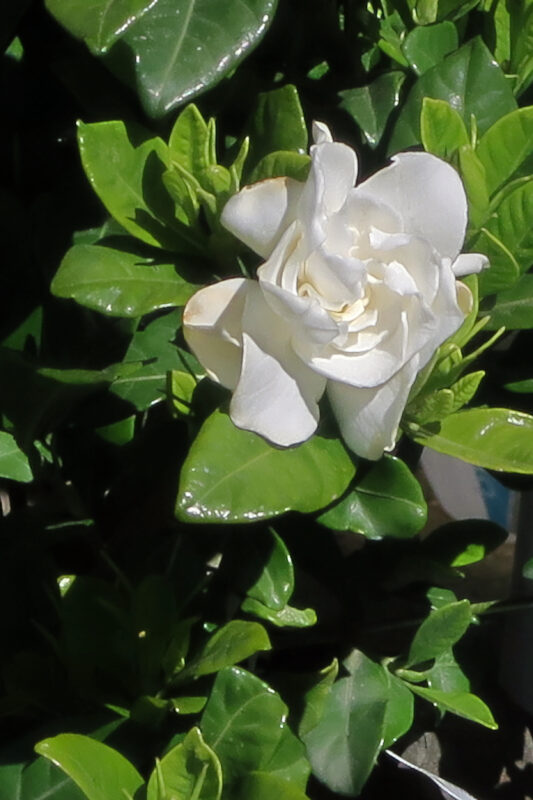
The Gardenia is a classic evergreen shrub known for its extravagant white flowers that emit a sweet, heady fragrance, reminiscent of warm summer evenings. Native to Asia and Africa, this shrub typically thrives in USDA zones 8-11. They prefer well-drained, acidic soil and benefit from a location with partial sunlight, as too much exposure can scorch their delicate leaves.
Caring for Gardenias can seem challenging, but with the right conditions, they can flourish. They require consistent moisture, so mulching can help retain soil moisture and regulate temperature. Regular pruning, ideally after flowering, helps maintain their shape and encourages more blooms in the following season. The gardenia’s alluring aroma makes it a perfect choice for an entrance garden or near patios, where its heavenly scent can be appreciated.
Japanese Pieris

Japanese Pieris, also known as Pieris japonica, is a stunning evergreen shrub that brings a sense of elegance to garden settings. This shrub produces drooping clusters of small, bell-shaped flowers that bloom in early spring, often before the leaves fully unfurl. Its glossy, dark green leaves are complemented by a brilliant red tint in the new growth, adding visual interest throughout the year.
This shrub prefers acidic, well-drained soils and can thrive in partially shaded areas, making it ideal for woodland gardens. Regular pruning after flowering encourages healthy growth and maintains its shape. The Japanese Pieris also supports wildlife, attracting bees and butterflies with its nectar-rich blooms, making it a great choice for environmentally friendly gardens.
Camellia
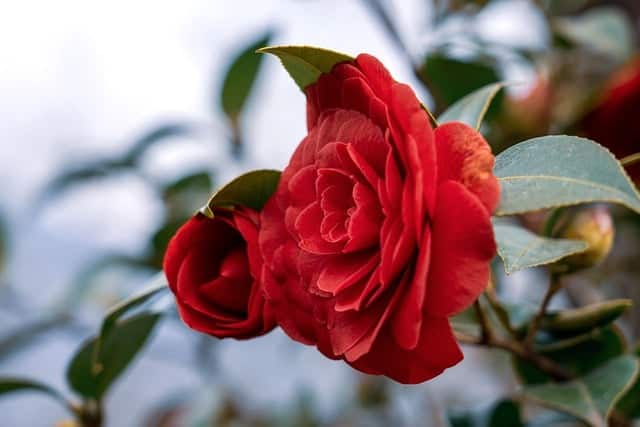
Camellia shrubs are beloved for their lavish blooms and glossy green foliage. With a variety of species and hybrids, bloom times can range from autumn through spring. Camellias come in shades of white, pink, red, and even bi-color varieties, allowing for versatile garden designs.
These shrubs prefer slightly acidic soil and a sheltered spot to protect them from harsh winds. Regular watering is essential, especially during dry spells, to keep them thriving. After flowering, light pruning helps to remove any dead or damaged branches, supporting healthy growth. They are ideal for southern gardens and provide a luxurious backdrop to other flowering plants.
Mountain Laurel
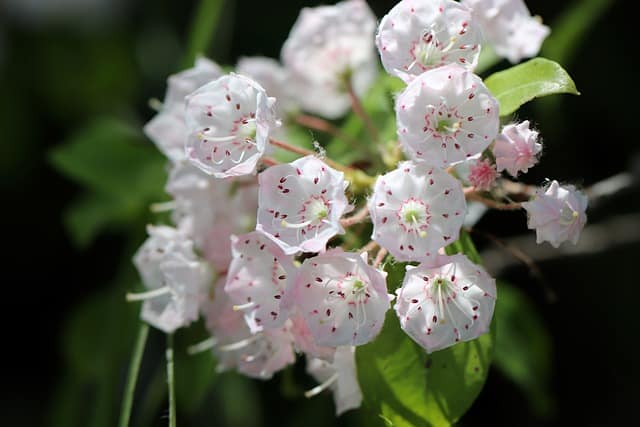
Mountain Laurel (Kalmia latifolia) is a native evergreen shrub known for its striking clusters of flowers that bloom in late spring. The flowers can range from white to pink and are borne in intricate, cup-shaped blooms that attract pollinators like bees and hummingbirds. Mountain Laurel’s leathery leaves remain vibrant throughout the winter, guaranteeing year-round interest.
This shrub prefers well-drained, acidic soils and thrives in partial shade to full sun. As they mature, Mountain Laurels require little maintenance but benefit from occasional pruning to promote air circulation and prevent fungal diseases. Planting them in a naturalistic garden setting creates a beautiful display while enhancing biodiversity.
Japanese Skimmia
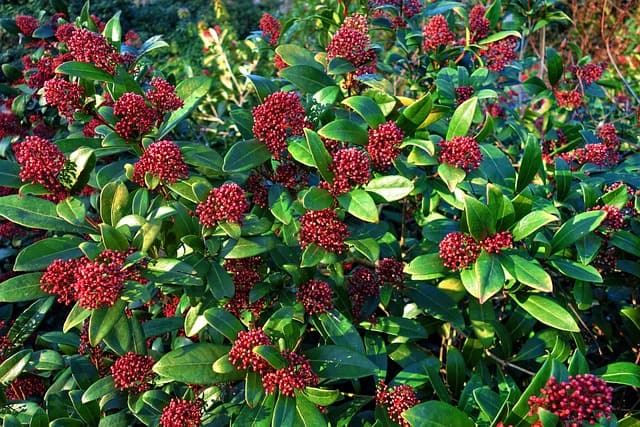
Japanese Skimmia, or Skimmia japonica, is an elegant and aromatic shrub perfect for shaded areas. These shrubs feature fragrant, white or pink flower clusters in spring, followed by attractive red berries in the fall that persist throughout winter, providing food for birds and adding visual interest.
They thrive in enriched, well-drained soil and can tolerate dry spells once established. Light pruning can help shape the shrub and remove any damaged branches. Their evergreen nature makes them excellent companions for other woodland plants, and their fragrance can delight anyone lucky enough to walk nearby.
Azalea
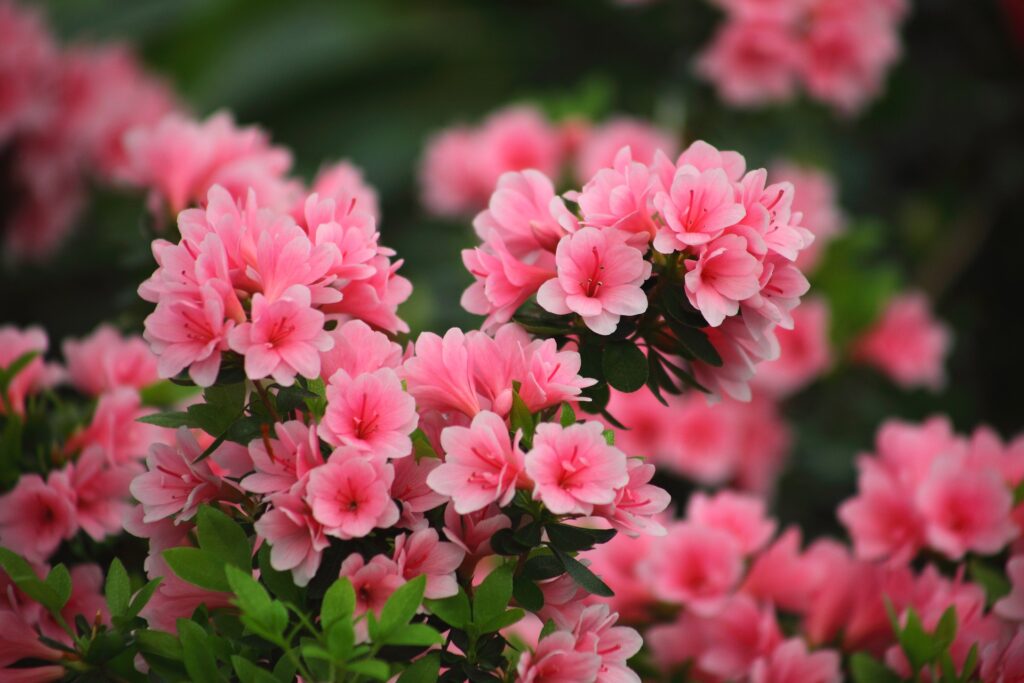
Azaleas, a member of the Rhododendron family, are cherished for their vibrant blooms and diverse color palette. Available in deciduous and evergreen varieties, evergreen azaleas provide all-year-round foliage while bursting into colorful blooms in spring and early summer.
These shrubs thrive best in acidic, well-drained soils and a spot that offers partial shade. Azaleas can be susceptible to diseases and pests, so regular monitoring and appropriate cultural practices can keep them healthy. They are often used in mass plantings for stunning displays or as specimen plants due to their breathtaking flowers and compact forms.
Cherry Laurel (Prunus laurocerasus)
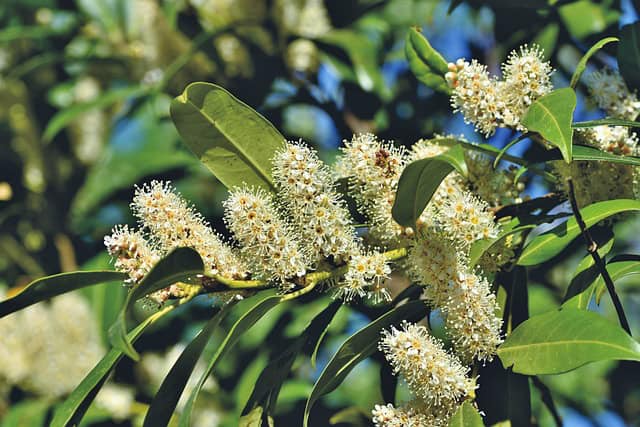
Cherry Laurel stands out for its lush, dark green leaves and fragrant white flowers that appear in spring. This hardy evergreen shrub is useful in hedging, privacy screens, or as a foundation planting. It can grow tall, providing an ideal backdrop for smaller flowers that bloom later in the season.
Cherry Laurel thrives in a variety of soil types, tolerating both sun and shade, which makes it versatile in the landscape. However, it can be invasive in some regions due to its rapid growth and seed production, so management is necessary. Its dense foliage makes it a favored choice for creating natural barriers while offering beautiful blooms.
Rhododendron
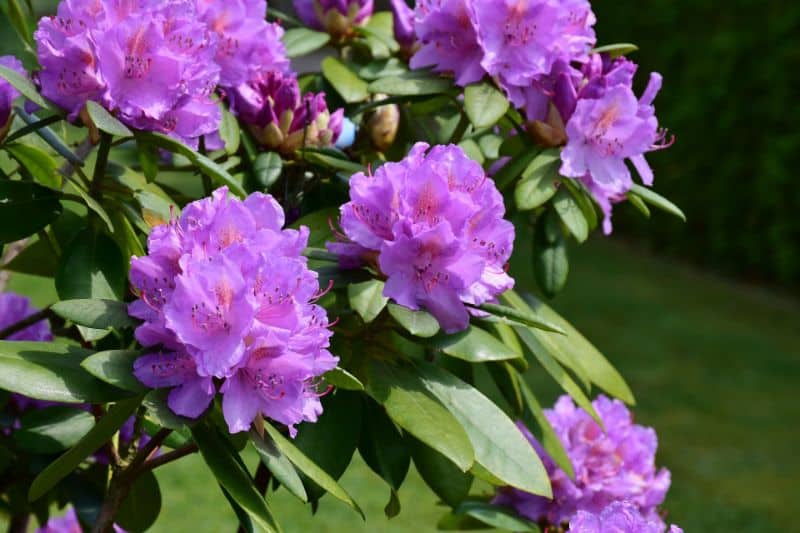
Rhododendrons are splendid evergreen flowering shrubs that can make a commanding presence in any landscape. They produce stunning clusters of large blooms in a variety of colors during the spring, attracting pollinators and adding vibrant life to the garden.
These shrubs generally prefer acidic, well-drained soil and a cool, partially shaded environment. They can be somewhat finicky about their conditions but, once established, they require little care. Periodic pruning after flowering helps encourage bloom production for the next year. Their grandeur and robust performance make them prized additions to any garden enthusiast’s collection.
Rockspray Cotoneaster

Rockspray Cotoneaster (Cotoneaster horizontalis) is a charming evergreen flowering shrub that’s often used for ground cover or cascading over walls. Its delicate white flowers bloom in spring, followed by glossy red berries in the fall, creating a feast for birds and contributing to seasonal interest.
This adaptable shrub thrives in well-drained soils and tolerates a variety of light conditions, although it prefers full sun for optimal growth. Routine maintenance includes pruning to expose the plant’s attractive form, particularly if it becomes overgrown. Using Rockspray Cotoneaster in a mixed border adds both visual texture and ecological balance to your garden.
Daphne
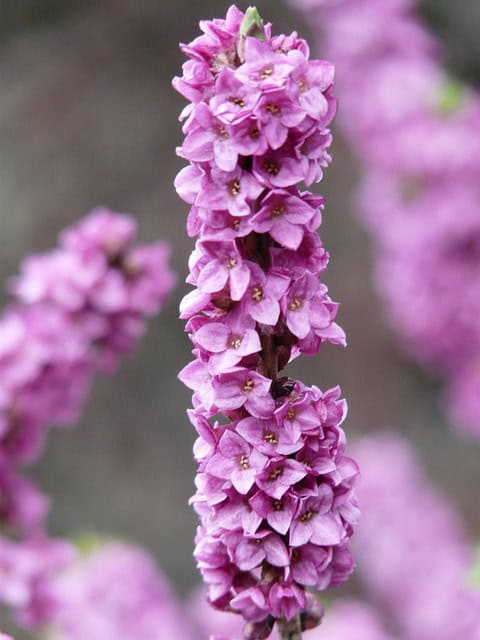
Daphne is a beautifully fragrant evergreen shrub that’s hard to resist. Known for its compact size and sweet-smelling flowers, Daphne blooms in late winter to early spring, providing one of the first bursts of color in the garden. The blooms vary from pink to white and attract early pollinators seeking sustenance.
Well-drained, slightly alkaline to neutral soil is optimal for Daphne, along with a spot that receives morning sun and afternoon shade. Their sensitivity to root disturbance makes planting challenging, so care should be taken during installation. Regular watering and the right placement will reward you with a robust display and intoxicating scents for many seasons.
Holly
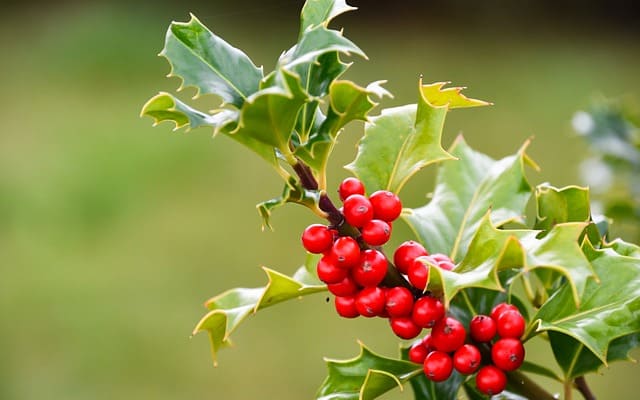
Holly, particularly the evergreen varieties, is a staple in many gardens thanks to its lustrous, spiny leaves and vibrant red berries. These shrubs produce clusters of white flowers, and the foliage provides year-round interest, particularly in winter when heavier snow highlights their structure.
Hollies prefer well-drained soil and can thrive in various light conditions, though they generally do best in partial shade. For optimal berry production, ensure male and female plants are placed near each other, as pollination is needed for berry development. Their sturdy nature makes them perfect for landscapes where resilience and seasonal beauty are desired.
Mahonia

Mahonia, or Oregon grape, is a unique evergreen shrub that thrives in shady areas. Its striking clusters of yellow flowers bloom in winter or early spring, followed by dark blue, grape-like berries that nourish birds through the cold months.
This hardy shrub prefers acidic, well-drained soil and requires little maintenance once established. Annual pruning encourages denser growth and fuller foliage. Mahonia’s adaptability to low-light conditions makes it an excellent addition to shaded garden spots, beautifying them with its bold presence.
Rosemary
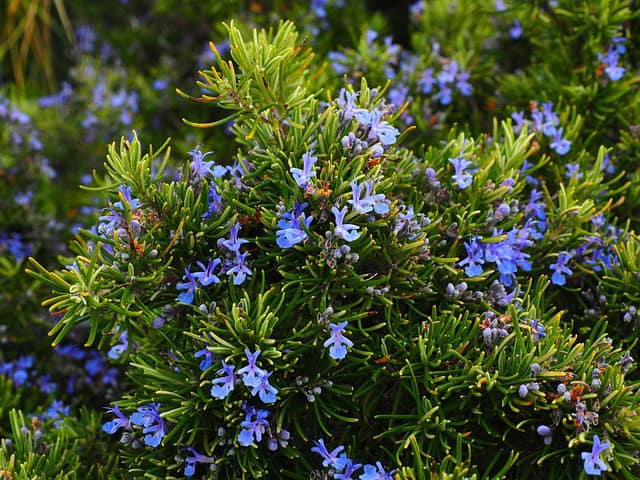
Rosemary is more than just a culinary herb; it’s also a lovely evergreen flowering shrub that provides texture and fragrance to gardens. This aromatic plant produces small, delicate blue flowers from spring to summer, attracting beneficial insects and pollinators.
A sunny spot with well-drained sandy or gravelly soil is perfect for Rosemary, allowing it to flourish. While it’s drought-tolerant once established, regular watering during dry spells helps ensure robust growth. Seasonal pruning aids in shaping and promoting new growth, making rosemary a delightful and functional addition to herb gardens or ornamental borders.
Abelia
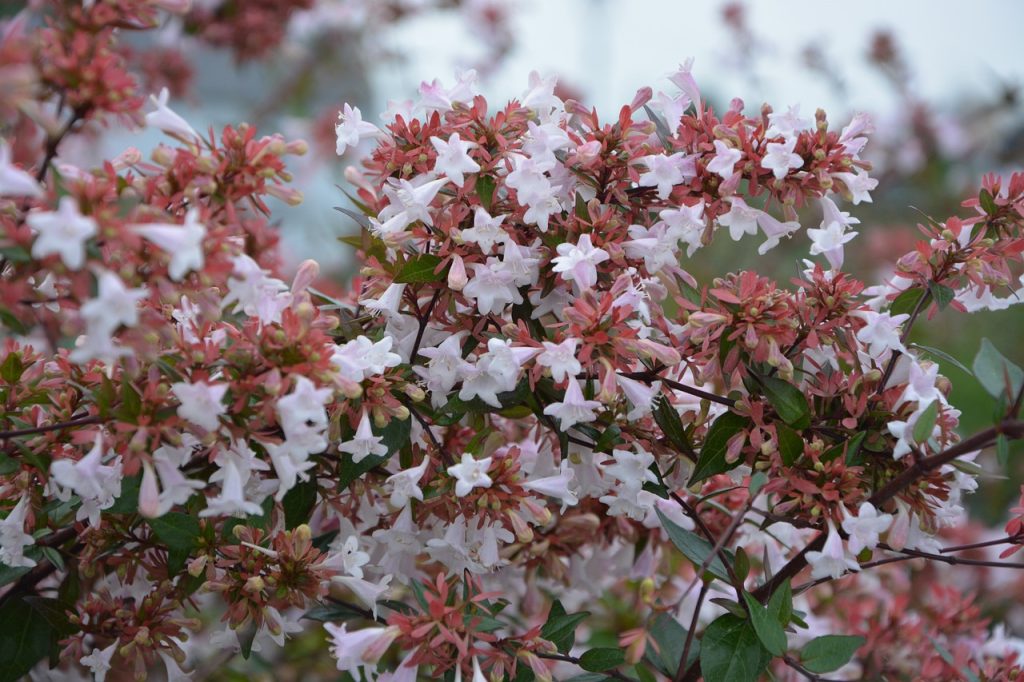
Abelia is a delightful evergreen shrub known for its arching branches and fragrant white or pink flowers that appear in summer and fall. This low-maintenance shrub is a great choice for spots that require splashes of color without much fuss, as it thrives in a range of conditions.
Abelias prefer well-drained soils and can thrive in full sun to partial shade. Regular pruning encourages new growth and helps maintain a neat shape. Their ability to attract butterflies and hummingbirds adds an ecological benefit, turning any garden into a vibrant haven for wildlife, all while maintaining minimal care requirements.
Japanese Pittosporum

Japanese Pittosporum is a versatile evergreen shrub celebrated for its glossy leaves and sweetly scented flowers. The fragrant blooms appear in spring, often attracting pollinators and adding an enchanting aroma to the garden.
This shrub thrives in well-drained, sandy soils and prefers full sun exposure for the best performance. While generally low-maintenance, occasional pruning can help manage its shape and size. Japanese Pittosporum works well in coastal gardens and provides an elegant, aromatic backdrop to other plants, offering both aesthetic and sensory pleasure.
Burkwood Viburnum

Burkwood Viburnum is an evergreen shrub that captivates with its stunning clusters of fragrant white flowers that bloom in late spring. It features glossy, deep green leaves, providing year-round visual interest alongside its beautiful blooms.
This shrub prefers well-drained soils and can tolerate both sun and shade, making it a versatile choice for various landscapes. Pruning after flowering helps shape the plant and encourages new growth. Planting it near patios or dining areas enhances outdoor spaces with its delightful fragrance, which can truly liven up an evening gathering.
Cape Jasmine (Gardenia jasminoides)

Cape Jasmine is a highly esteemed variety of Gardenia, known for its large, creamy white flowers and intoxicating fragrance. These blooms are more prominent compared to other gardenias, making this shrub a standout choice for gardens seeking a touch of luxury.
They thrive best in warm climates (USDA zones 8-11) and prefer rich, acidic, well-drained soil. Regular watering and careful management of pests like aphids can help keep Cape Jasmine healthy. Its abundant blooms make it a perfect candidate for borders and fragrant gardens, creating enchanting experiences for anyone who wanders by.
Virginia Sweetspire (Itea virginica)
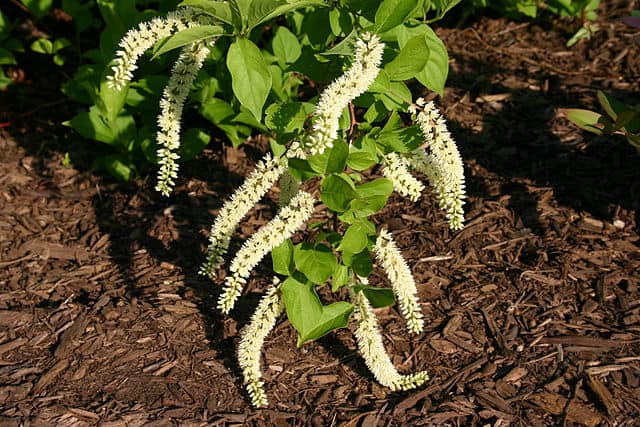
Virginia Sweetspire is an adaptable, deciduous shrub that adds color and fragrance to the garden throughout the seasons. Known for its elegant, arching branches and fragrant, white flower spikes that emerge in late spring, it attracts butterflies and other pollinators.
This shrub flourishes in moist, well-drained soils and tolerates both sun and shade. Regular pruning supports healthy growth and encourages a fuller shape. Virginia Sweetspire suits a wide range of landscapes, particularly alongside water features, where its beauty can be reflected, creating stunning visual displays.
Japanese Skimmia (Skimmia japonica)

Mentioned earlier, Japanese Skimmia holds a unique charm as a quirky evergreen, but deserves additional recognition for its ornamental versatility. Renowned for its distinct clusters of fragrant white flowers, this shrub blooms in spring, later producing bright red berries that linger into winter.
It thrives in shaded or partially shaded areas, preferring well-drained, acidic soil. The compact growth habit makes it an excellent choice for container gardens or small spaces. Skimmia can enhance the beauty of rock gardens or serve as an appealing foundation planting, adding both elegance and interest to the landscape.
Mountain Doghobble (Leucothoe fontanesiana)

Mountain Doghobble is a lesser-known, evergreen flowering shrub that delivers delicate white, bell-shaped flowers in the spring, resembling clusters of lily-of-the-valley blooms. The arching branches and evergreen foliage provide lush interest despite its more subdued flower display.
This shrub thrives in acidic, well-drained soils and typically prefers partial to full shade, making it perfect for woodland gardens. It also holds up well against tougher conditions, tolerating drought once established. Mountain Doghobble can create an enchanting atmosphere when placed among ferns or other shaded plants that celebrate its unique charm.
Bottlebrush (Callistemon viminalis ‘Little John’)
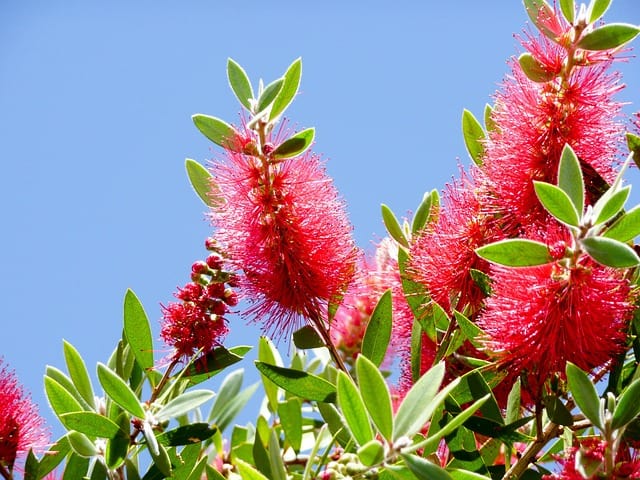
Bottlebrush, particularly the ‘Little John’ variety, has a unique appearance that stands out in any garden. Known for its vibrant red, brush-like flowers that resemble a bottle cleaning brush, this evergreen shrub attracts bees and hummingbirds during its flowering season.
It prefers well-drained soil and thrives in full sun. Regular pruning encourages bushier growth and enhances its aesthetics. The drought-tolerant nature of this shrub makes it an ideal choice for low-maintenance landscapes, while its striking color can brighten up any border or rock garden.
Chinese Fringe Flower (Loropetalum chinense)
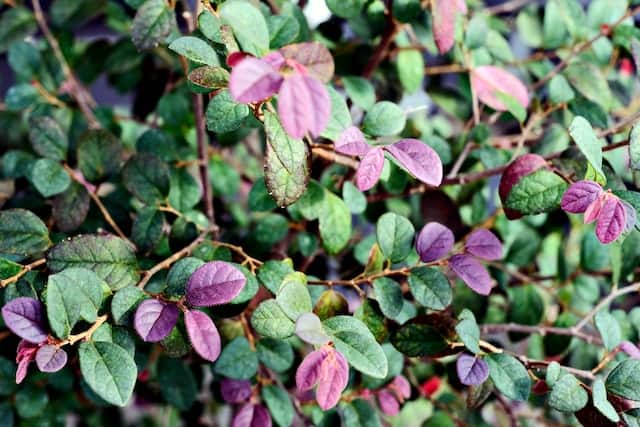
Chinese Fringe Flower is an exquisite evergreen shrub that delights with its pink or white fringe-like flowers that appear in spring. The unique, strappy blooms and burgundy foliage provide spectacular contrast, making it a favorite among gardeners seeking to create focal points.
It prefers well-drained soils and thrives in partial to full sun. Pruning after the flower has faded enhances its shape and health. The Chinese Fringe Flower works well in both formal and informal gardens, providing stunning interest with its bold color and distinctive bloom structure.





